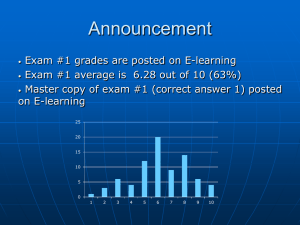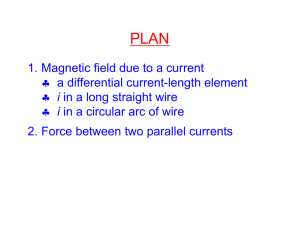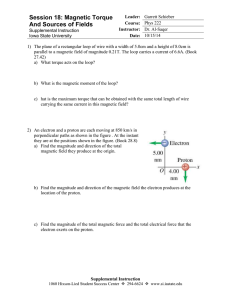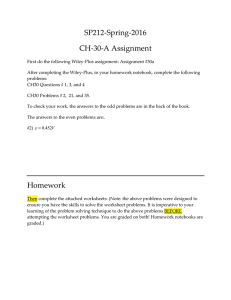Magnetostatics 1 Physics 142
advertisement
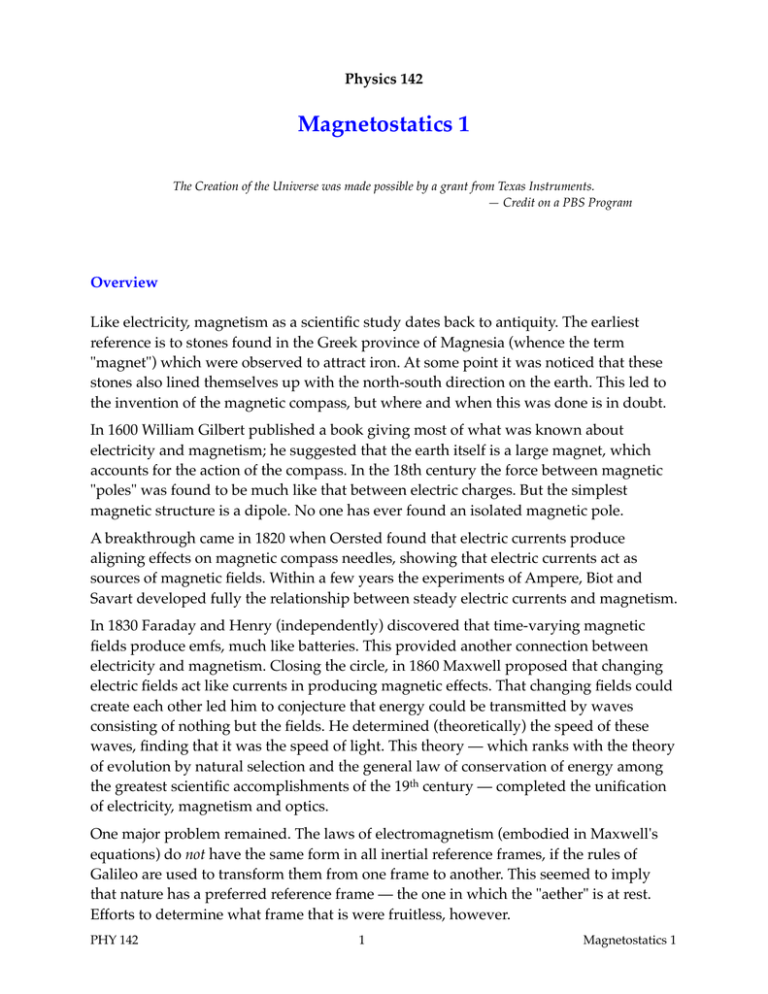
Physics 142 Magnetostatics 1 The Creation of the Universe was made possible by a grant from Texas Instruments. — Credit on a PBS Program Overview Like electricity, magnetism as a scientific study dates back to antiquity. The earliest reference is to stones found in the Greek province of Magnesia (whence the term "magnet") which were observed to attract iron. At some point it was noticed that these stones also lined themselves up with the north-south direction on the earth. This led to the invention of the magnetic compass, but where and when this was done is in doubt. In 1600 William Gilbert published a book giving most of what was known about electricity and magnetism; he suggested that the earth itself is a large magnet, which accounts for the action of the compass. In the 18th century the force between magnetic "poles" was found to be much like that between electric charges. But the simplest magnetic structure is a dipole. No one has ever found an isolated magnetic pole. A breakthrough came in 1820 when Oersted found that electric currents produce aligning effects on magnetic compass needles, showing that electric currents act as sources of magnetic fields. Within a few years the experiments of Ampere, Biot and Savart developed fully the relationship between steady electric currents and magnetism. In 1830 Faraday and Henry (independently) discovered that time-varying magnetic fields produce emfs, much like batteries. This provided another connection between electricity and magnetism. Closing the circle, in 1860 Maxwell proposed that changing electric fields act like currents in producing magnetic effects. That changing fields could create each other led him to conjecture that energy could be transmitted by waves consisting of nothing but the fields. He determined (theoretically) the speed of these waves, finding that it was the speed of light. This theory — which ranks with the theory of evolution by natural selection and the general law of conservation of energy among the greatest scientific accomplishments of the 19th century — completed the unification of electricity, magnetism and optics. One major problem remained. The laws of electromagnetism (embodied in Maxwell's equations) do not have the same form in all inertial reference frames, if the rules of Galileo are used to transform them from one frame to another. This seemed to imply that nature has a preferred reference frame — the one in which the "aether" is at rest. Efforts to determine what frame that is were fruitless, however. PHY 142! 1! Magnetostatics 1 This problem was resolved in 1905 by the theory of special relativity, largely due to Einstein. Maxwell's equations are indeed the same in all inertial frames, if the correct transformation rules are used. The Galilean rules are approximations to these, valid when the relative velocity of the two frames is small compared to the speed of light. We begin our discussion with static magnetic fields (independent of time). Then we discuss steady currents as sources of magnetic fields. Later on we will discuss another important source of magnetic fields, an electric field that is changing with time. A third source of magnetic fields, the intrinsic magnetic properties of “elementary” particles such as the electron, and of atoms, gives rise to the “magnets” familiar to everyone. This kind of magnetism was the last to be understood, and requires quantum theory to explain it. We therefore omit detailed study of it. The magnetic force on a moving charge We will describe magnetic effects in terms of a vector field B, called the magnetic field. Like the electric field, the magnetic field is defined operationally in terms of the force it produces on a test object. In this case the test object is a moving point charge. Ampere discovered that a magnet exerts a sideways force on a wire carrying a current. Since we now know that currents arise from moving microscopic charges (usually electrons) we can interpret this force in terms of forces on individual charges. It took a long time for physicists of the 19th century to discover what a current actually is; the description of it in terms of moving microscopic charges didn’t take hold until about 1880. The force law given below is often called the “Lorentz force” after the physicist who worked out the theory in the 1890’s. The experiments show the following about the magnetic force on a moving charge: • The magnitude of the force is proportional to the speed of the charge. • The direction of the force is perpendicular to the velocity of the charge. • The magnitude of the force is proportional to the magnitude of the charge. These properties are summarized in a fundamental law giving the magnetic force on a moving charged particle. It serves as the operational definition of B. F = qv × B Magnetic force law (Lorentz force) Since the force is perpendicular to v, it does no work. It can change the direction of the charged particle’s motion, but not its speed. The SI unit of B is the Tesla (T), a large unit. The field of the earth is about 5 × 10−5 T. Force on a wire carrying current A current in a wire is the net effect of many moving charges, so we can find the force on such a wire by adding the forces on the individual charges. PHY 142! 2! Magnetostatics 1 Consider an infinitesimal section of wire as shown, with current indicated by the direction of the current density. Let the number of charge carriers per unit volume be n, and let each carrier have charge q. If the average (drift) velocity is v, then j = nqv . j A dl In the volume A dl of the infinitesimal section there are nA dl moving charges. The total force on these charges is thus dF = (qv × B)(nA dl) = j × B(A dl) . The total current in the wire is I = jA . We define a vector dl , in the direction of j with magnitude dl , so we have jdl = j dl . This allows us to write the force in the form dF = I dl × B Magnetic force on current element The total force on a finite piece of wire (or a whole circuit) can be found by integrating this expression along the wires. In general this is complicated because of the vector product and the variation of B from point to point on the wire. But the result is simple if the piece of wire is straight and the B-field is uniform: Straight wire in uniform field: F = I l × B Here the magnitude of the vector l is the length of the wire. The force exerted by magnetic fields on wires carrying currents is the basis of most electric motors, and is therefore of great technological importance. Force and torque on a current loop From the formula for dF one can calculate the forces on the various parts of a loop of wire carrying a current I. These forces can give rise to a net force, or a torque, or both. For the net force we have Ftot = ∫ I dl × B , where the integral covers the path taken by the wire loop. If the B-field is uniform, one can prove that the total force is simply zero. For in that case B can be moved outside the integral: Ftot = ( ∫ dl) × IB . The integral in parentheses is the total displacement in a closed path, which is zero. The torque on the loop may not be zero, however, even if the Bfield is uniform. Consider for simplicity a rectangular loop; to get the force on each side we use the formula for a straight wire. The situation is shown in edge-on view. The vector A has magnitude equal to the area of the loop and direction normal to the surface bounded by the loop. PHY 142! 3! B θ A ⊗ I Magnetostatics 1 The force on the wire carrying current into the page (denoted by ⊗ ) is to the right, and the force on the opposite wire (denoted by ) is to the left. These forces are equal and opposite, but not along the same line; they create a clockwise torque tending to align A with the field B. (The forces on the other wires are along the same line, canceling and giving no torque.) The formula for this torque is usually expressed in terms of the magnetic moment of the current loop. For the case of a loop lying in a plane, the magnetic moment is given by µ = IA Magnetic moment of current loop There is a "right-hand rule" to tell which way µ points: Curl the fingers of the right hand the way the current flows around the loop; the thumb points in the direction of the magnetic moment. In terms of the magnetic moment, the torque on the loop is simple: τ =µ×B Torque on magnetic moment This is similar to the torque on an electric dipole moment in an E-field. If the B-field is not uniform, then there may also be a net force on the loop. The rule for the direction of this force is like the one in the electric case: if the magnetic moment is aligned with the field, it will be attracted toward the region of stronger field. This is why magnets attract bits of iron. On the other hand, if µ is aligned opposite to B, then it is repelled from the region of stronger field. “Permanent” magnets have relatively large magnetic moments arising from the intrinsic moments of their atoms. The operation of the magnetic compass arises from the aligning torque exerted on the permanent magnet needle by the earth's B-field. Motion of charged particles in a B-field As we have seen, a B-field causes a force on a moving charged particle. This force is always perpendicular to the velocity, like the radial force in circular motion, serving to change the direction of the motion without changing the speed. In fact, a particle with velocity perpendicular to a uniform B-field will describe a circle. The magnitude of the force in this case is F = qvB . From the circular motion equation: qvB = m v2 , r so the particle describes a circle of radius PHY 142! 4! Magnetostatics 1 r= mv qB The frequency of revolution is f = qB v = . 2π r 2π m This is called the "cyclotron" frequency. Note that it is independent of the speed. This formula is a “classical” approximation valid when v is small compared to the speed of light c. For particles with speeds close to c, one must use the correct relativistic formula for the momentum of a particle. This has the effect of making the cyclotron frequency decrease with increasing speed. A particle moving at an arbitrary angle relative to a uniform B-field has velocity components both perpendicular and parallel to the field. The component perpendicular to the field results in circular motion, but the component along the line of the field is unaffected by the field; the resulting trajectory is a helix. Charged particles (mostly protons from the sun) trapped in the Van Allen belts of the earth describe helical motion around the field lines as they move back and forth between the magnetic poles. The radius of the circle described by a charged particle in a uniform B-field is proportional to its mass, so one can measure m by measuring this radius. This is the basic principle of mass spectrometers, which measure masses of atoms and molecules. It is possible to arrange E and B fields that produce zero total force on a moving particle if it has a particular velocity. This configuration acts as a “velocity selector”. Consider the situation shown. Charged particles pass through holes in both screens 1 and 2, assuring that they are all going horizontally. They then encounter a region with fields are arranged perpendicular to each other and to the particle's velocity. The total force on the particle is E v B 1 2 3 Ftot = qE + qv × B . The two parts of the force are in opposite directions (up and down, respectively, if q is positive) and will cancel exactly if v= E . B Particles with this speed will also pass through the hole in screen 3; those with other speeds will be deflected and miss this hole. This assures that all particles passing through all three holes have the same velocity. PHY 142! 5! Magnetostatics 1

